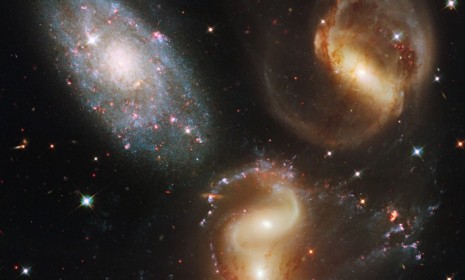What's the 'anti-universe' — and can scientists find it?
An entire universe made of anti-matter might exist somewhere, say scientists. Will a new space-based detector offer proof for this mind-bending theory?

It sounds like something out of a comic book, but scientists say an "anti-universe" may exist — and we could be on the verge of discovering it. Here's an instant guide:
Is there really an anti-universe?
Theoretically, yes. Our universe is almost entirely matter, but cosmologists say that the Big Bang must have produced an equal amount of anti-matter. The problem of where that anti-matter has gone is known as the "baryon assymetry." One theory goes that an entire universe of anti-matter could exist on the edge of our own.
The Week
Escape your echo chamber. Get the facts behind the news, plus analysis from multiple perspectives.

Sign up for The Week's Free Newsletters
From our morning news briefing to a weekly Good News Newsletter, get the best of The Week delivered directly to your inbox.
From our morning news briefing to a weekly Good News Newsletter, get the best of The Week delivered directly to your inbox.
How could we possibly find it?
Using an Alpha Magnetic Spectrometer. One of these futuristic-sounding devices is set to be installed at the International Space Station next year. The 8.5 ton instrument is designed to detect dark matter in our own universe, but it "may also answer questions not yet asked," says Robert Evans at ABC News.
What's the difference between dark matter and anti-matter?
Dark matter exists in our universe — in fact, scientists think it may make up 23 percent of it — but it's incredibly difficult to detect as it does not reflect light. Anti-matter is the opposite of matter, and barely exists in our universe at all. Matter and anti-matter annihilate each other on contact, creating energy.
A free daily email with the biggest news stories of the day – and the best features from TheWeek.com
How easy will the anti-universe be to detect?
Not easy. Both matter and anti-matter will produce light in the same way, so scientists say the only way to detect an anti-matter region is to identify the boundary that keeps it separate from a matter-dominated region. The annihilation reactions within that boundary would produce gamma rays, and it is these that the Alpha Magnetic Spectrometer may be able to detect from deep space.
What would the anti-universe contain?
We have no idea. Science fiction writers have long imagined it to be a mirror image of our own universe, with the capacity to produce life — a theory that some scientists actually subscribe to. In any case, so little is known about it that no theory is too far-fetched. NPR's Ron Elving, for example, claims the anti-universe exists in Alaska, though his proof — Tea Partier Joe Miller's primary win over Sen. Lisa Murkowski (R-AK) — is unscientific, to say the least.
-
 Who is fuelling the flames of antisemitism in Australia?
Who is fuelling the flames of antisemitism in Australia?Today’s Big Question Deadly Bondi Beach attack the result of ‘permissive environment’ where warning signs were ‘too often left unchecked’
-
 Bulgaria is the latest government to fall amid mass protests
Bulgaria is the latest government to fall amid mass protestsThe Explainer The country’s prime minister resigned as part of the fallout
-
 Codeword: December 15, 2025
Codeword: December 15, 2025The daily codeword puzzle from The Week